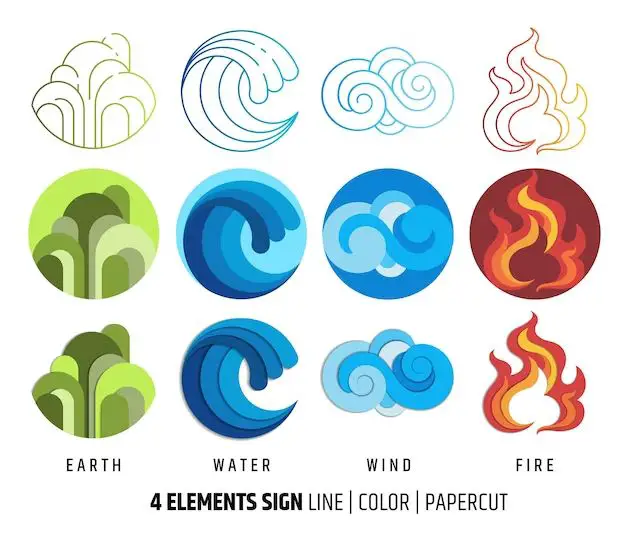The 4 classic elements of earth according to ancient philosophies are air, earth, fire and water. These elements make up the basic components of the physical world. Each element is associated with unique properties and symbolic colors that reflect their essence.
The concept of the 4 elements dates back over 2,500 years to the writings of the ancient Greek philosophers. The Greek philosopher Empedocles proposed the existence of 4 elements in the 5th century BC, which later became adopted in Western philosophy and medieval alchemy. The 4 elements represent the basic components that everything in the physical world is made up of.
Each element is associated with different qualities and attributes. The colors linked to the elements are symbolic representations of their essence and energy. Understanding the elemental colors provides deeper insight into the nature of the 4 elements.
Air
Air represents the gaseous state of matter as well as attributes like intelligence, communication and mobility. It is considered a masculine element and seen as outwardly directed energy.
The symbolic color of air is: Yellow. This is because yellow symbolizes the energy and warmth of intellect. Yellow lightens and raises energy, reflecting the mobility of air. It represents enlightenment and optimism, which are qualities associated with the air element.
Earth
Earth represents the solid state of matter as well as qualities like grounding, stability and materiality. It is seen as a feminine element and as inwardly directed energy.
The symbolic color of earth is: Green. This is because green reflects growth, fertility and the abundant vibrations of the earth. Green is the color of nature, vegetation and life, connecting to the earthy qualities of the element. It represents nurturing, balance and harmony.
Fire
Fire represents the energetic state of matter as well as qualities like inspiration, leadership and purification. It is seen as a masculine element and as an outwardly directed energy.
The symbolic color of fire is: Red. This is because red reflects the heat, passion and urgent vibrations of fire. Red holds the most intense energy in the color spectrum, mirroring the energetic essence of fire. It represents power, drive, determination and action.
Water
Water represents the liquid state of matter as well as attributes like emotion, intuition and flow. It is considered a feminine element and seen as inwardly directed energy.
The symbolic color of water is: Blue. This is because blue reflects the calm, deep vibrations of water. Blue has a soothing, peaceful energy, mirroring the tranquil qualities of water. It represents patience, sensitivity and imagination.
The Elements in Balance
While each element has its own distinct energetic color, the elements work best in harmony with one another. When the 4 elements are balanced, they complement each other through their combined properties.
The balance of elemental colors creates an equilibrium that is reflected in the ideal proportions of:
- 25% Air (Yellow)
- 25% Fire (Red)
- 25% Water (Blue)
- 25% Earth (Green)
When the colors are balanced, the result is a healthy alignment and flow between the physical, mental, emotional and spiritual levels.
Imbalances in Elemental Colors
An imbalance in the elemental colors can create discord and dysfunction. Here are some examples:
- Excess Fire may lead to anger, aggression or impulsivity.
- Excess Water may lead to overwhelm, lethargy or depression.
- Excess Air may lead to anxiety, distraction or information overload.
- Excess Earth may lead to stagnation, laziness or resistance to change.
Understanding the elemental colors and how they interact can reveal areas of imbalance. Steps can then be taken to restore harmony among the elements.
Ways to Balance the Elemental Colors
Here are some ways to balance the elemental colors when there is disharmony among the elements:
- Introduce more of the color that is lacking.
- Limit exposure to colors that are excessive.
- Engage in activities that cultivate the deficient element.
- Make dietary changes to align with elemental weaknesses.
- Use meditation, visualization or affirmations focused on colors.
- Wear gemstones or essential oils aligned to strengthen elements.
- Make changes to environment, like adding plants, lighting or décor.
The Elements Reflected in Nature
The elemental colors are reflected throughout the natural world:
| Element | Color | Found in Nature |
|---|---|---|
| Air | Yellow | Sunlight, lightning, pollen |
| Earth | Green | Forests, mountains, trees |
| Fire | Red | Lava, deserts, volcanoes |
| Water | Blue | Oceans, lakes, rivers |
Observing the balance of elemental colors in the natural world can cultivate an inner balance as well. Notice areas where certain colors may be missing or overabundant.
Conclusion
The 4 elements of earth, each represented by a symbolic color, form the basic building blocks of the physical realm. Air is yellow, earth is green, fire is red and water is blue. When balanced, the elements and their colors create harmony. An excess or deficiency in any elemental color can lead to energetic disharmony and dysfunction. By observing the balance of elemental colors, both inwardly and outwardly in nature, steps can be taken to restore equilibrium.
Understanding the energetic meaning behind the colors linked to the elements provides a valuable framework. The interplay and influence of elemental colors reveals deeper insights into oneself and the world at large. Harnessing the power of color can be a profound tool on the journey toward wholeness, balance and wellbeing.

